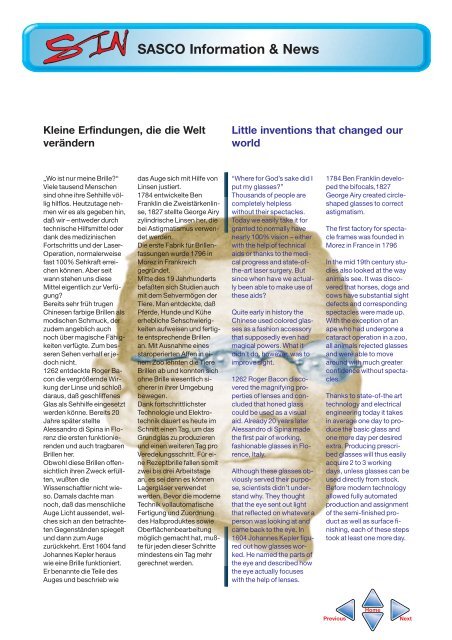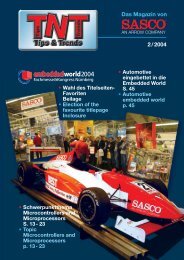steht die TNT als PDF zum Download - ISI-Design
steht die TNT als PDF zum Download - ISI-Design
steht die TNT als PDF zum Download - ISI-Design
Erfolgreiche ePaper selbst erstellen
Machen Sie aus Ihren PDF Publikationen ein blätterbares Flipbook mit unserer einzigartigen Google optimierten e-Paper Software.
Kleine Erfindungen, <strong>die</strong> <strong>die</strong> Welt<br />
verändern<br />
„Wo ist nur meine Brille?“<br />
Viele tausend Menschen<br />
sind ohne ihre Sehhilfe völlig<br />
hilflos. Heutzutage nehmen<br />
wir es <strong>als</strong> gegeben hin,<br />
daß wir – entweder durch<br />
technische Hilfsmittel oder<br />
dank des medizinischen<br />
Fortschritts und der Laser-<br />
Operation, normalerweise<br />
fast 100% Sehkraft erreichen<br />
können. Aber seit<br />
wann stehen uns <strong>die</strong>se<br />
Mittel eigentlich zur Verfügung?<br />
Bereits sehr früh trugen<br />
Chinesen farbige Brillen <strong>als</strong><br />
modischen Schmuck, der<br />
zudem angeblich auch<br />
noch über magische Fähigkeiten<br />
verfügte. Zum besseren<br />
Sehen verhalf er jedoch<br />
nicht.<br />
1262 entdeckte Roger Bacon<br />
<strong>die</strong> vergrößernde Wirkung<br />
der Linse und schloß<br />
daraus, daß geschliffenes<br />
Glas <strong>als</strong> Sehhilfe eingesetzt<br />
werden könne. Bereits 20<br />
Jahre später stellte<br />
Alessandro di Spina in Florenz<br />
<strong>die</strong> ersten funktionierenden<br />
und auch tragbaren<br />
Brillen her.<br />
Obwohl <strong>die</strong>se Brillen offensichtlich<br />
ihren Zweck erfüllten,<br />
wußten <strong>die</strong><br />
Wissenschaftler nicht wieso.<br />
Dam<strong>als</strong> dachte man<br />
noch, daß das menschliche<br />
Auge Licht aussendet, welches<br />
sich an den betrachteten<br />
Gegenständen spiegelt<br />
und dann <strong>zum</strong> Auge<br />
zurückkehrt. Erst 1604 fand<br />
Johannes Kepler heraus<br />
wie eine Brille funktioniert.<br />
Er benannte <strong>die</strong> Teile des<br />
Auges und beschrieb wie<br />
SASCO Information & News<br />
das Auge sich mit Hilfe von<br />
Linsen justiert.<br />
1784 entwickelte Ben<br />
Franklin <strong>die</strong> Zweistärkenlinse,<br />
1827 stellte George Airy<br />
zylindrische Linsen her, <strong>die</strong><br />
bei Astigmatismus verwendet<br />
werden.<br />
Die erste Fabrik für Brillenfassungen<br />
wurde 1796 in<br />
Morez in Frankreich<br />
gegründet.<br />
Mitte des 19 Jahrhunderts<br />
befaßten sich Stu<strong>die</strong>n auch<br />
mit dem Sehvermögen der<br />
Tiere. Man entdeckte, daß<br />
Pferde, Hunde und Kühe<br />
erhebliche Sehschwierigkeiten<br />
aufweisen und fertigte<br />
entsprechende Brillen<br />
an. Mit Ausnahme eines<br />
staroperierten Affen in einem<br />
Zoo lehnten <strong>die</strong> Tiere<br />
Brillen ab und konnten sich<br />
ohne Brille wesentlich sicherer<br />
in ihrer Umgebung<br />
bewegen.<br />
Dank fortschrittlichster<br />
Technologie und Elektrotechnik<br />
dauert es heute im<br />
Schnitt einen Tag, um das<br />
Grundglas zu produzieren<br />
und einen weiteren Tag pro<br />
Veredelungsschritt. Für eine<br />
Rezeptbrille fallen somit<br />
zwei bis drei Arbeitstage<br />
an, es sei denn es können<br />
Lagergläser verwendet<br />
werden. Bevor <strong>die</strong> moderne<br />
Technik vollautomatische<br />
Fertigung und Zuordnung<br />
des Halbproduktes sowie<br />
Oberflächenbearbeitung<br />
möglich gemacht hat, mußte<br />
für jeden <strong>die</strong>ser Schritte<br />
mindestens ein Tag mehr<br />
gerechnet werden.<br />
Little inventions that changed our<br />
world<br />
“Where for God’s sake did I<br />
put my glasses?”<br />
Thousands of people are<br />
completely helpless<br />
without their spectacles.<br />
Today we easily take it for<br />
granted to normally have<br />
nearly 100% vision – either<br />
with the help of technical<br />
aids or thanks to the medical<br />
progress and state-ofthe-art<br />
laser surgery. But<br />
since when have we actually<br />
been able to make use of<br />
these aids?<br />
Quite early in history the<br />
Chinese used colored glasses<br />
as a fashion accessory<br />
that supposedly even had<br />
magical powers. What it<br />
didn’t do, however, was to<br />
improve sight.<br />
1262 Roger Bacon discovered<br />
the magnifying properties<br />
of lenses and concluded<br />
that honed glass<br />
could be used as a visual<br />
aid. Already 20 years later<br />
Alessandro di Spina made<br />
the first pair of working,<br />
fashionable glasses in Florence,<br />
Italy.<br />
Although these glasses obviously<br />
served their purpose,<br />
scientists didn’t understand<br />
why. They thought<br />
that the eye sent out light<br />
that reflected on whatever a<br />
person was looking at and<br />
came back to the eye. In<br />
1604 Johannes Kepler figured<br />
out how glasses worked.<br />
He named the parts of<br />
the eye and described how<br />
the eye actually focuses<br />
with the help of lenses.<br />
1784 Ben Franklin developed<br />
the bifoc<strong>als</strong>,1827<br />
George Airy created circleshaped<br />
glasses to correct<br />
astigmatism.<br />
The first factory for spectacle<br />
frames was founded in<br />
Morez in France in 1796<br />
In the mid 19th century stu<strong>die</strong>s<br />
<strong>als</strong>o looked at the way<br />
anim<strong>als</strong> see. It was discovered<br />
that horses, dogs and<br />
cows have substantial sight<br />
defects and corresponding<br />
spectacles were made up.<br />
With the exception of an<br />
ape who had undergone a<br />
cataract operation in a zoo,<br />
all anim<strong>als</strong> rejected glasses<br />
and were able to move<br />
around with much greater<br />
confidence without spectacles.<br />
Thanks to state-of-the art<br />
technology and electrical<br />
engineering today it takes<br />
in average one day to produce<br />
the basic glass and<br />
one more day per desired<br />
extra. Producing prescribed<br />
glasses will thus easily<br />
acquire 2 to 3 working<br />
days, unless glasses can be<br />
used directly from stock.<br />
Before modern technology<br />
allowed fully automated<br />
production and assignment<br />
of the semi-finished product<br />
as well as surface finishing,<br />
each of these steps<br />
took at least one more day.<br />
Home<br />
Previous Next




